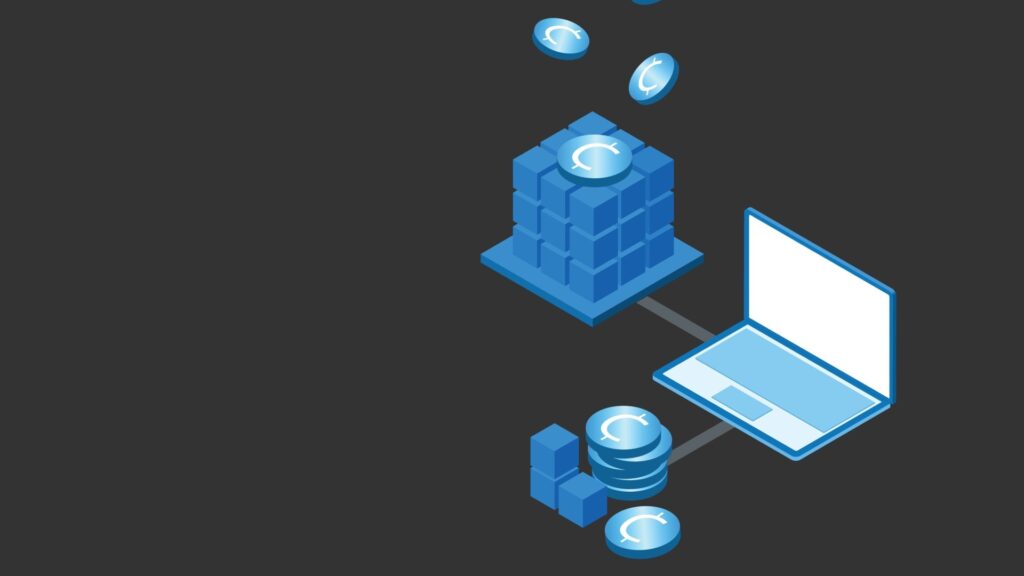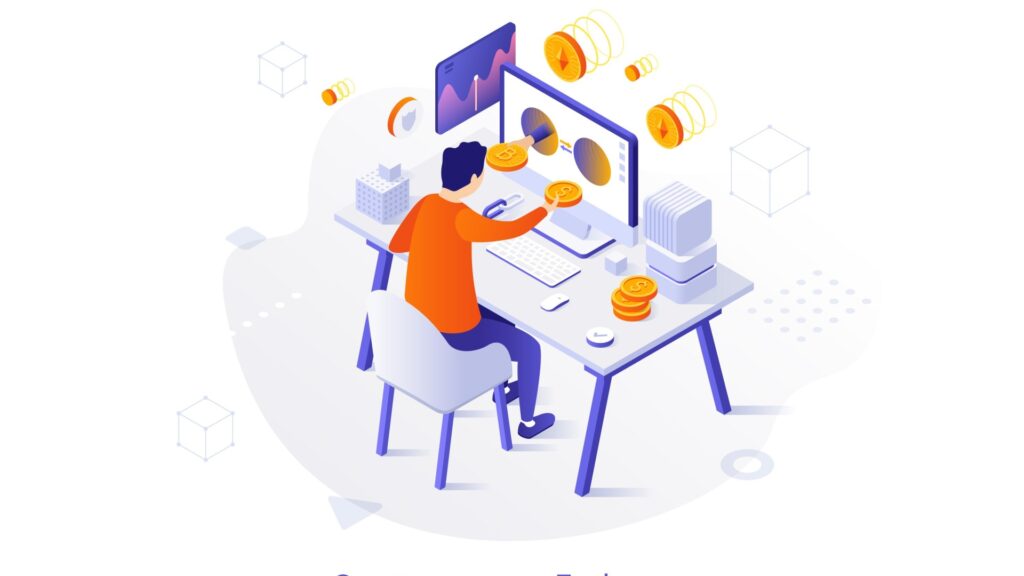What Is Liquidity Mining?
In the crypto industry, liquidity mining is defined as the process of earning rewards by investing assets in various liquidity pools. In other words, it is an opportunity to earn a stable passive income by using your tokens to provide liquidity to decentralised exchanges.
Although the primary strategy for investing in crypto is still considered to be holding — buying and holding the currency for a long time until it increases in value — other methods of earning money are becoming increasingly popular. We are talking specifically about liquidity mining — the mechanism of the decentralised finance system, in which participants of the process transfer part of their tokens to the exchange, for which they receive a commission. The distribution of this percentage, i.e. commission, depends on the liquidity each currency holder contributes. Therefore, the participants are called liquidity providers.
How Did Liquidity Mining Come About?
Before such an organisation of monetary relations as decentralised finance emerged, crypto assets were mostly intensively traded or held to gain income from their value growth. Therefore, crypto market participants were limited in their actions and ways of earning money. However, all that changed with the advent of DeFi (decentralised finance) — it allowed them to earn passive income by using their assets as liquidity on decentralised exchanges, credit protocols and liquidity pools.
Such free trading attracted many new participants. Moreover, the protocols offered substantial rewards — for example, the annual rate of return on investments reached triple digits. All this stimulated the active growth and development of DeFi and, thus, liquidity mining.
Thus, the DeFi system changed the usual model of traditional centralised financial exchanges. The automated market maker, or AMM, emerged, facilitating cryptocurrency trading between holders through liquidity pools. In other words, AMM has eliminated the need to centralise exchanges. The pools are formed through smart contracts and managed by special algorithms, thus ensuring autonomy. Liquidity, however, increases in proportion to how participants transfer their assets.
Therefore, liquidity mining is an effective strategy for generating passive income. After all, you are still the owner of your asset and can withdraw it at any time. By transferring the currency to a decentralised exchange, or DEX, you will also receive a regular commission for the coins provided.
What Is a Liquidity Mining Pool?

Firstly, let's clarify that liquidity measures how quickly and easily a currency can be bought or sold in the crypto industry. High liquidity implies that many buyers and sellers in the market are ready to conduct transactions and deals, which contributes to price stability. Low liquidity, on the other hand, indicates fewer offers. Therefore, exchanges strive to achieve high liquidity because such assets are more attractive and less risky for traders.
A liquidity pool is a decentralised fund of cryptocurrency assets collected in smart contracts, allowing holders to carry out transactions with tokens without intermediaries. It is how liquidity and the ability to trade on decentralised exchanges using the automatic AMM mechanism are ensured.
Liquidity pools are designed to incentivise participants called liquidity providers, or LPs. They are awarded tokens for contributing their assets to the liquidity pools. After a certain period, LPs are rewarded with a portion of fees and incentives equivalent to the amount of liquidity they have contributed, called liquidity provider tokens (LPT). LPs can then use their tokens in different ways. Thus, many decentralised exchanges, such as Uniswap, rely on liquidity pools.
Yield Farming vs Liquidity Mining
In fact, liquidity mining is one of the varieties of yield farming and staking. Let's remember that yield farming is one of the popular trends in the DeFi system, which is placing or lending crypto assets in return for high interest or direct income. In other words, this is an additional opportunity to invest assets and make a profit. Of course, yield farming is also closely related to liquidity mining, but it is not the same as mining.
Yield farming is a broader and far more complex strategy that includes liquidity mining and other areas, such as investing in credit protocols to issue crypto loans to other users. Furthermore, liquidity mining, as we've already established, generates passive income by supplying liquidity to DeFi pools.
Yield farming differs from liquidity mining in another equally important factor. In liquidity mining, participants profit from commissions on the platform and receive an additional reward or compensation — a native token. That is, liquidity miners, while receiving a native blockchain token as compensation, have the opportunity to purchase governance tokens. It enables them to participate in any structure and empower each participant.
Yield farming involves more handwork than other strategies if all processes are done correctly. Cryptocurrencies invested by the participant are also involved in these processes, and to achieve liquidity, yield farming involves multiple blockchains, which definitely increases the risks. However, the extra effort and dangers still bring substantial returns.
Benefits and Risks of Liquidity Mining

Liquidity mining can be a very lucrative investment, as annual interest rates tend to be often in the double or even triple digits. Thus, the key advantages that make currency holders choose liquidity mining are:
- receiving passive income, that is, the opportunity to benefit from providing liquidity without having to take any active action and manage your positions;
- high returns, but it is essential to clarify that the returns are proportional to the total investment and risk the currency holder takes. Thus, the investments provided are used mainly to facilitate decentralised transactions, so the rewards also tend to come as trading commissions. Every transaction accrues them over time, and transactions occur on a particular exchange. In other words, the share in the liquidity pool also determines the profit, so you can estimate it even before investing. For example, if there is high activity in the market, the rewards will be high;
- a low entry threshold, since participation in mining is available to virtually everyone. That is, as long as the user owns a wallet to interact with the decentralised exchange and stores a certain number of coins, they have all the opportunities to provide liquidity. Rewards for this can be redirected to the pool and thereby increase your base capital, as well as your share in the pool, to receive higher commissions in the future;
- a variety of protocols and pools for investing and further receiving rewards, or the ability to choose the most suitable one for a particular user;
- additional distribution of project management tokens allows you to participate in their development and growth.
However, making high profits comes with serious risks. Among them are the following:
- the risk of imminent losses, or IL, which is defined as the opportunity cost of holding an asset for speculative purposes versus making it available as liquidity to earn fees. Since digital assets are highly volatile, it is virtually impossible to avoid IL. If the asset in the selected LP loses or gains too much value after making a deposit, the user risks not making a profit or losing the money invested;
- the risk of protocols and projects, which is due to the technical peculiarities of liquidity mining that are unique to each protocol. If the protocol and the code on which it runs have not been seriously tested, there is a high risk that fraudsters will take advantage of the protocol and the assets it contains. Awareness, confidence in security and caution will provide the right level of protection.
- the risk of rug pull, which is the name for another type of scam in the crypto market. Rug pull occurs when developers create a token combined with a valuable cryptocurrency, place it on decentralised exchanges, wait for investors to buy it, and then withdraw all funds. Scammers usually carry out rug pulls by creating hype around the coin, abandoning the project, and absconding with all the money. Since all decentralised protocols provide anonymity, you can launch projects without verification or registration. Hence, it is imperative to conduct thorough research and gain knowledge about the investment opportunities available to you. Compounder Finance is a prominent example of a crypto rug pull, whose developers shut down the project in 2020 and absconded with nearly $11 million in investor assets, allegedly using a backdoor coding mechanism.
In any case, investing involves risks that are almost impossible to avoid. But you should be aware of them in advance to mitigate them, minimise their impact or eliminate the likelihood of their occurrence.
Is DeFi Liquidity Mining Legal?
Liquidity mining is a legitimate profit-making tool and an effective earning strategy. By providing liquidity via DeFi protocols, users get rewards through additional tokens or commissions. This investment strategy is legal, and the activities of miners are absolutely within the law.
Nevertheless, it is essential to note that liquidity mining is not without risks. For instance, the same scammers exist in the crypto industry, and exchanges can be subject to hacker attacks. Therefore, ensuring that the protocol, the code, and the project you invest in are reliable and safe before you start is essential.
How to Start Mining Liquidity

To start mining liquidity, you need to choose an appropriate protocol. For example, you can use the Uniswap protocol of the decentralised exchange of the same name. DEXs allow buyers and sellers to connect and exchange various cryptocurrency tokens without involving a third-party trading platform.
Next, you must go to the Uniswap website and create a particular non-custodial wallet using the “Connect Wallet” button. Trust Wallets allow users complete control over their crypto. In other words, you won't be able to hand over the management of your assets to a third party, such as an exchange or storage service. Therefore, non-custodial wallets are much safer.
Following that, you should click “New Position” and select the trading pair to which you want to provide liquidity. For example, one of the most popular pairs on Uniswap is Ethereum and Tether. Next, choose a reward level tied to the different interest rates charged to traders. The most common and stable coins tend to have lower pool fees, while rarer coins have correspondingly higher fees.
Once you have entered the liquidity volume you can provide for a trading pair, the required amount is automatically generated. By clicking on the “Add” button, you provide liquidity. Next, you collect your liquidity tokens and wait for the rewards.
Conclusion
So, liquidity mining is one of the many ways to generate passive income in the crypto market. Simultaneously, it is the most effective and profitable strategy because, by understanding all the possible risks and threats, you can try to avoid them and regularly receive a stable, high income without making any significant efforts. Moreover, liquidity mining is easy to implement and available for everyone. It does not create fear with a high entry threshold and allows any user to get involved. Interestingly, this process resembles a familiar bank deposit, i.e. depositing money at a specific interest rate, with potential profits increasing significantly over time. However, as with any financial decision, such investments should be treated cautiously, so do not forget to consider all the likely risks when mining liquidity.